Advertisements
Advertisements
प्रश्न
Consider the following and choose the correct answer with the help of given codes-
| STAGES OF POPULATION | GROWTH FEATURES |
| I Period between 1901 to 1921 | 1. Period of steady growth |
| II Period between 1921 to 1951 | 2. Phase of stagnant growth of Population |
| III Period between 1951 to 1981 | 3. High but decreasing growth rate |
| IV After 1981 till present | 4. Period of population explosion |
पर्याय
I - 1, II - 2, III - 3, IV - 4
I - 2, II - 1, III - 4, IV - 3
I - 4, II - 3, III - 2, IV - 1
I - 2, II - 1, III - 3, IV - 4
उत्तर
I - 2, II - 1, III - 4, IV - 3
APPEARS IN
संबंधित प्रश्न
With the help of suitable diagram describe the logistic population growth curve.
Answer the following question.
Compare, giving reasons, the J-shaped and S-shaped models of population growth of a species.
Identify the correct correlation :
A: Assertion; R: Reasoning
A: Population of a region does not change.
R: Birth rate, death rate, and migration affect the population of a region.
Identify the correct correlation :
A: Assertion; R: Reasoning
A: In stage 2, the death rate reduces but the birth rate is constant.
R: The population increases rapidly in stage 2.
Give a geographical reason:
Population may increase though birth rates are low.
Differentiate between
Crude Birth Rate and Crude Death Rate
Push factors and pull factors of migration.
What is population doubling time?
Which country has the highest and lowest growth rate of the population respectively?
What is population growth? What does population change indicate for an area?
Distinguish between the place of origin and the place of destination.
Define the term ‘positive growth of population’.
Why do people migrate in large numbers from rural to urban areas in India?
What was the population of India as per the 2011 Census?
The growth of population rate per decade is ______.
The continent that has the highest growth rate of population.
The continent that has the lowest growth rate of population.
Which of the following is not a pull factor?
The country having lowest growth rate of population.
Which one of the following is not a component of population change?
How many times the world population has increased during the last 500 years?
Which is the most populated country?
Which of these statements is not true?

Which is not in stage III?
When the birth rate is more than the death rate between two points of time, it is known as ______
Study the given graph carefully and answer the following question:
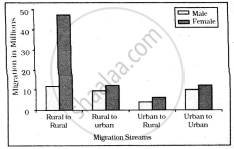
Intra-state Migration by place of Last Residence Indicating Migration Streams India, 2011
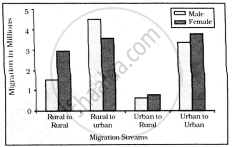
Inter-state Migration by Place of Last Residence Indicating Migration Streams India, 2011
Who dominates the intra-state migration of short distances?
The number of mice in a laboratory was 100 on a particular day. After one year their number increased to 120. Calculate the growth rate in the population.
Ratio between mortality and neutrality is called ______.
In an exponential bacterial culture, the number of cells/ml is plotted o half log group. The growth is ______.
Exponential growth in plants win be expressed as ______.
Which of the following statement is true?
(i) CBR = Bi/P × 1000
(ii) COR = D /P × 1000
(iii) If birth rate is more than death rate, then CBR results in positive growth of population.
Which of the following pairs is not correctly matched?
Which of the following formula correctly depicts natural growth of population?
Which of the following forms the component of a nation?
In the exponential growth equation Nt = Noert, e represents ______
If a population of 50 Paramoecium present in a pool increases to 150 after an hour, what would be the growth rate of population?
In 2005, for each of the 14 million people present in a country, 0.028 were born and 0.008 died during the year. Using exponential equation, the number of people present in 2015 is predicted as ______.
A population of Paramoecium caudatum was grown in a culture medium. After 5 days the culture medium became overcrowed with Paramoeium and had depleted nutrients. What will happen to the population and what type of growth curve will the population attain? Draw the growth curve.
Swathi was growing a bacterial colony in a culture flask under ideal laboratory conditions where the resources are replenished. Which of the following equations will represent the growth in this case?
(Where population size is N, birth rate is b, death rate is d, unit time period is t, and carrying capacity is K).
Which of the following may be interpreted as a spontaneous effort to achieve a better balance between population and resources?
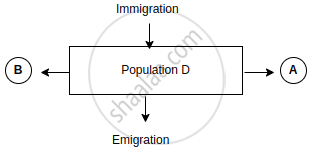
Observe the schematic representation given above and answer the following questions:
- Identify A and B.
- Calculate the growth rate of bacteria in a curd sample, where 1 million bacteria increased to two million, within a period of one hour.
"Migration may be interpreted as a spontaneous effort to achieve a better balance between population and resources." Examine the statement in context of pull and push factors that influence migration.
A : Population of a region does not change.
R : Birth rate, death rate and migration affect the population of a region.
A: The population of a region does not change.
R: Birth rate, death rate and migration affect the population of a region.
A: Assertion; R: Reasoning
A: The population of a region does not change.
R: Birth rate, death rate and migration affect the population of a region.
Assertion (A): Population of a region does not change.
Reasoning (R): Birth rate, death rate and migration affect the population of a region.
Assertion (A): Population of a region does not change.
Reasoning (R): Birth rate, death rate and migration affect the population of a region.
Assertion: Population of a region does not change.
Reasoning: Birth rate, death rate and migration affect the population of a region.
Study the two figures shown below that represent two growth models.
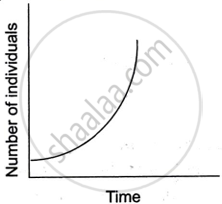 |
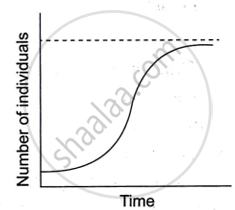 |
| Figure A | Figure B |
- Which one of the two figures represents an unlimited supply of nutrients? Give a reason.
- Which figure depicts a challenge to population growth?
- Explain the term reproductive fitness.
- Give the mathematical expressions for Figure A and Figure B.
Assertion : Population of a region does not change.
Reasoning : Birth rate, death rate and migration affect the population of a region.
